Artist Spotlight, History Of Comics
10 Most Influential Comic Book Artists Part 2
by Joshua H. Stulman
This article covers the Top 5 of our Top 10 list (Check out our Part One article). The top 5 was chosen carefully, not just by technical skill or popularity. Artists in the Top 5 were so pervasive in influence on other artists as well as popular culture that without these artists the comic book industry as we know it today would not exist.
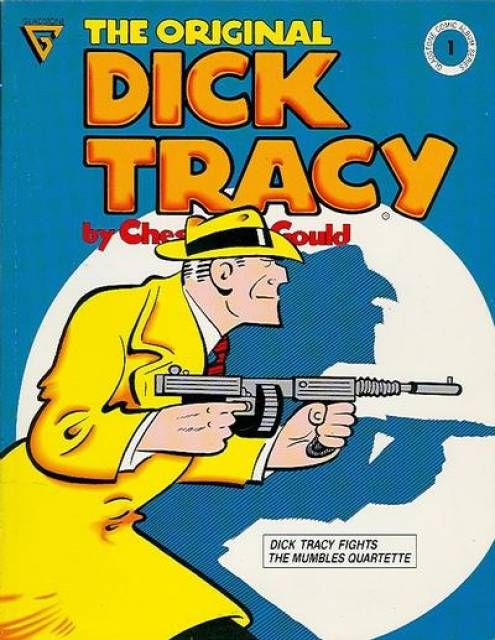
5) Chester Gould
Chester Gould (1900-1985) created Dick Tracy in 1931. Dick Tracy rapidly became the top adventure comic strip. Gould’s Dick Tracy paved the way for multimedia comic properties. Soon after his introduction to readers, Dick Tracy received a radio show in 1934 and a film serial in 1937. Several films featured Dick Tracy in the 1940’s-1950’s as well as a 1960’s cartoon series. During the Pop Art movement, Gould’s art on Dick Tracy was recreated by Andy Warhol in 1960. Warren Beatty’s Dick Tracy film featuring Beatty, Madonna and Al Pacino introduced the character to a new generation. Gould was a major lasting influence on DC’s Batman and the entire concept of Batman’s rouge gallery. Gould’s interest in policing and technology was mimicked by writers on Batman, while Gould’s unique art-style was a direct influence on golden age legends including Jack Kirby and Dick Sprang.
4) Jack Kirby
Jack Kirby (1917-1994) is widely recognized today as one of the greatest creators of the comic book industry. Beginning his career in ernest in 1939 working for comic book packager, Eisner & Iger, Kirby soon partnered with Joe Simon. The pair created Captain America in 1941 for Marvel Comics, which was the first superhero to take on the Nazi threat. The Kirby & Simon team continued their work at DC where they created the Boy Commandos, a top selling magazine at the time as well as re-inventing Sandman. Outside the superhero genre, the team expanded the Romance comics genre and Western comics in the late 1940’s. He continued to work for both Marvel and DC during the 1950’s and infused his stories with science fiction technology or creative monsters. Much of these themes were the basis of his work at Marvel were he and Stan Lee laid the foundation for the modern Marvel Universe. Together they created the Fantastic Four, Thor, Hulk, Ant Man, Iron Man, Silver Sufer and the X-Men to name a few. Kirby & Simon’s The Fly was one of the sources of inspiration for Spider-Man. In fact Kirby was the first artist to work on the initial concept. When he left Marvel for DC, he continued his interest in modern myth-making with his Fourth World saga, which introduced Darkseid. He is known by artists for his dynamic power in illustration and his other-worldly concepts and costume designs. His layouts and art-style became the Marvel house style by which all new artists had to learn. His later defiance to Marvel over creator rights and artwork rights was the source of inspiration for Image Comics. Having died in 1994, Kirby continues to be honored, studied, and remembered to this day.
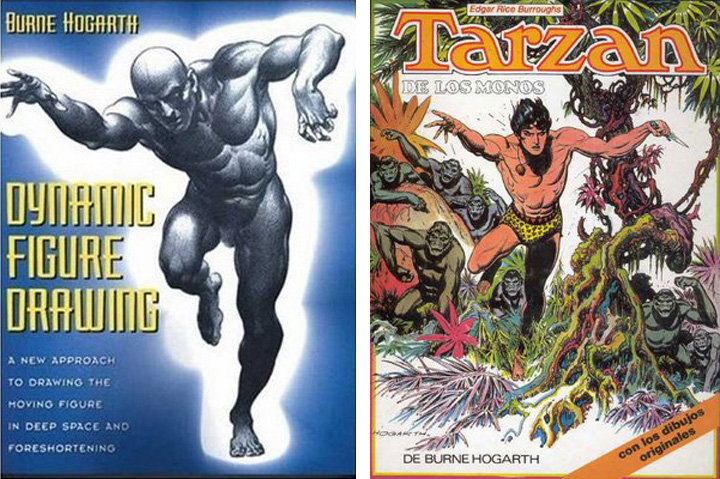
3) Burne Hogarth
Burne Hogarth (1911-1996) is one of the four major influences on early comic book artists. He became known as the cartoonist on the Tarzan newspaper comic strip beginning in 1936. Hogarth’s artwork was fused with classical illustration and expressionism based on human anatomy. His anatomical posing was mimicked by many of the early comic artists. This can be especially seen in Bill Everett’s rejected cover for Marvel Comics #1 (1939). He also had a profound influence on Joe Kubert both in Kubert’s art illustration and as a basis for the Joe Kubert School. Along with his comic strip work, Hogarth was an academic and a teacher. He wrote several books on figure, anatomy, and drapery which remain mandatory reading in art schools today. He co-founded the Cartoonists and Illustrators School in 1947, which would become one of the leading art institutions in the nation. Now called the School of Visual Arts (SVA), Hogarth designed the original curriculum and would later employ comic art veterans, like Will Eisner, as part of its faculty. Hogarth’s work is recognized around the globe and through the formation of SVA, he trained multiple generations of illustrators.
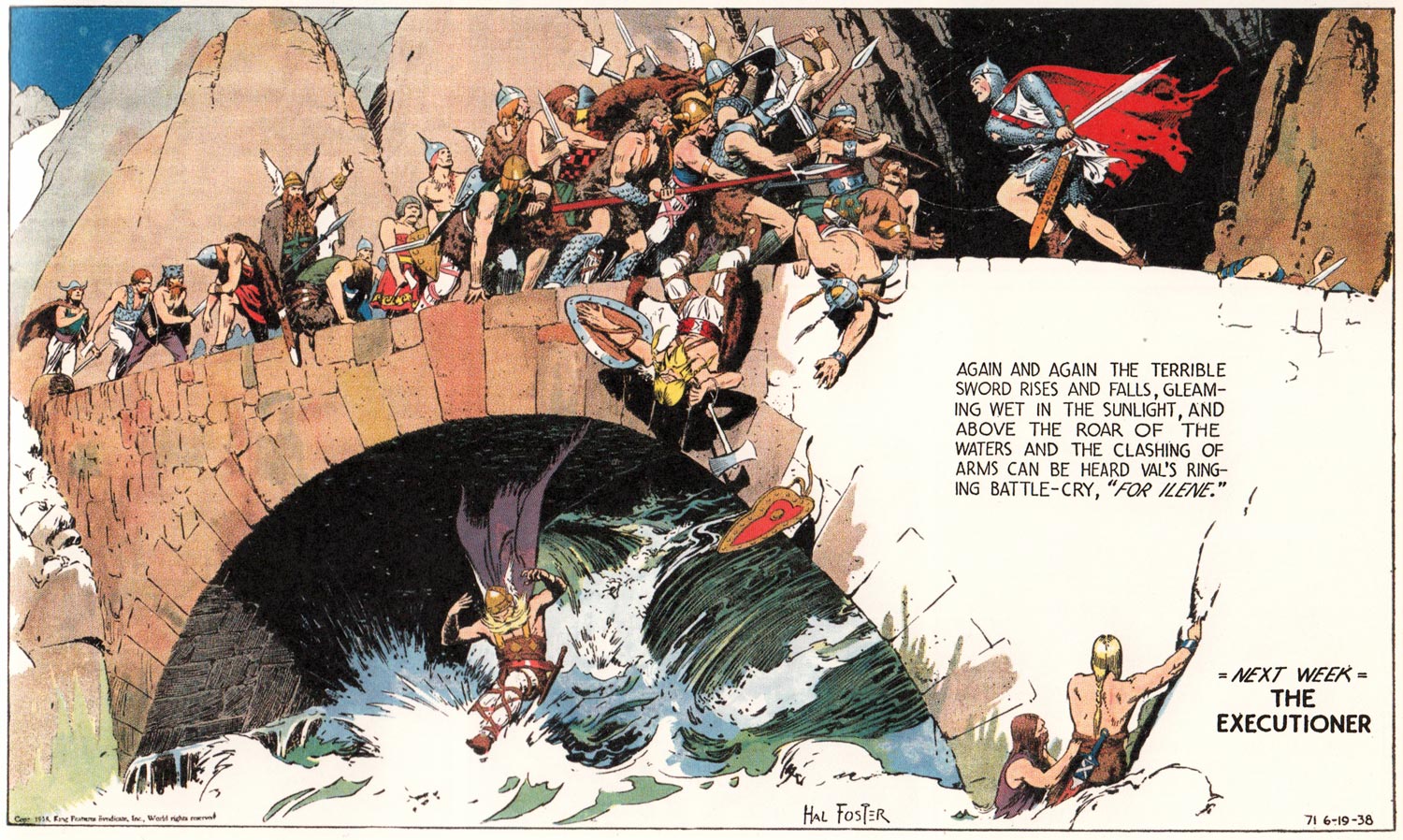
2) Hal Foster
Hal Foster (1892-1982) is highly revered by illustrators and comic artists alike. He began the Tarzan comic strip in 1929 and stayed on it until he passed it to Burne Hogarth. His keen attention to costume, figures, and panel design created a sense of epic illustration that was organized in the same manner of a painting. His greatest and most associated work was the creation of Prince Valiant (of which he owned 50% of the profits). Foster worked on the strip from in 1937 to 1975. His artwork was greatly admired by the early superhero illustrators including Jack Kirby and Bob Kane, for which they used Foster’s artwork as a template. Foster’s artwork expanded the comic strip genre to include medieval history and an interest in accurate portrayal of figures, clothing, and scenery. His impact on the comic industry is evident by nearly every artist in this “Top Ten” list paying tribute to his artwork and influence.
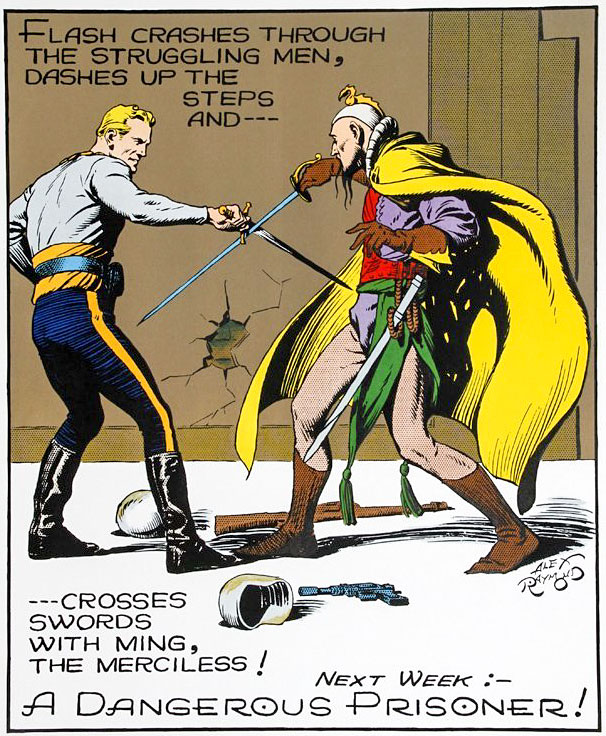
1) Alex Raymond
Alex Raymond (1909-1956) tops our “Top 10 Most Influential Comic Book Artists.” Without a doubt, Raymond was a versatile artist working in a variety of styles that revolutionized the comic industry. He created Jungle Jim (1934) to compete both in style and genre with Hal Foster’s Tarzan. At the same time, Raymond also worked on the Secret Agent X-9 spy strip, a precursor to James Bond. Raymond greatest success was with Flash Gordon, created to compete with Buck Rogers. Although unlike other imitators, Raymond infused the strip with futuristic space technology, alien races like the Hawk Men, and the quintessential villain Ming, The Merciless. George Lucas credits Alex Raymond’s Flash Gordon as the major influence for Star Wars. The strip ran from 1934-2003, with Raymond’s tenure ending in 1944 when he was drafted to World War II.
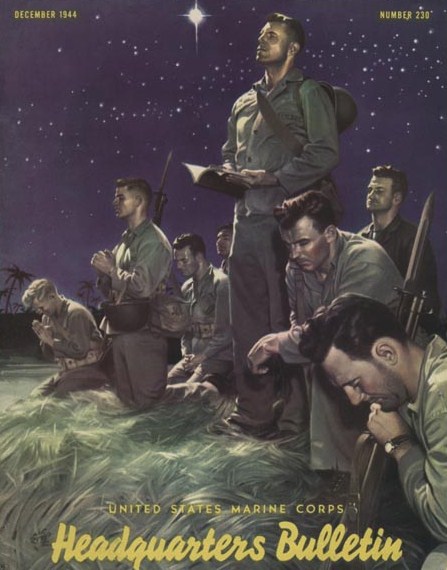
At war, he served as a Marine and saw combat in the Eastern Pacific. He also painted “Marines at Prayer” recruitment poster which demonstrates Raymond’s technical skills as a realistic painter. After his return from WWII, Raymond was assigned Rip Kirby. Much like Raymond himself, Rip Kirby was an ex-Marine adapting to civilian life. Kirby was a New York City Private Detective, which allowed for plenty of adventure. Unlike traditional noir, Kirby had a steady girlfriend and a mild-mannered assistant. The character was level headed and didn’t suffer the stereotypical affinity to alcohol.
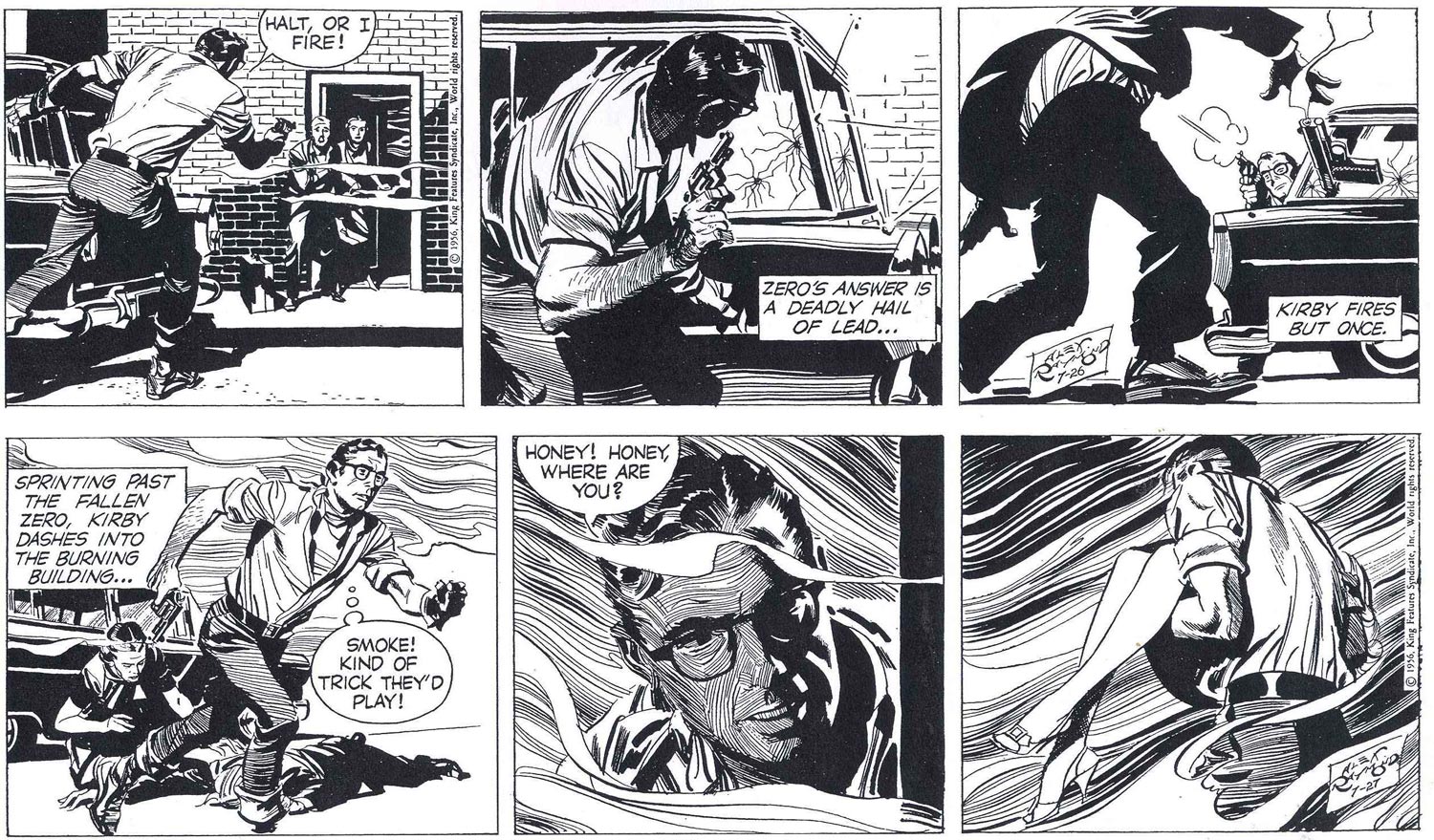 Rip Kirby was Alex Raymond’s final comic strip before his sudden death in 1956 due to a car crash. The strip was entirely done in black and white. To “color” the strip, Raymond used a sweeping array of illustration techniques to create a variety of tones. His innovative storytelling was championed by many comic book artists in the 1950’s and became the textbook by which artists like Neal Adams built their careers. Raymond’s influence was recognized during his lifetime having won several industry awards. Countless artists mimicked his style both in working on his comic strips and in other strips and comics. He was credited by Jack Kirby as a major influence on his artistic outlook. Today, Alex Raymond’s legacy lives on and continues to inspire artists to this day.
Rip Kirby was Alex Raymond’s final comic strip before his sudden death in 1956 due to a car crash. The strip was entirely done in black and white. To “color” the strip, Raymond used a sweeping array of illustration techniques to create a variety of tones. His innovative storytelling was championed by many comic book artists in the 1950’s and became the textbook by which artists like Neal Adams built their careers. Raymond’s influence was recognized during his lifetime having won several industry awards. Countless artists mimicked his style both in working on his comic strips and in other strips and comics. He was credited by Jack Kirby as a major influence on his artistic outlook. Today, Alex Raymond’s legacy lives on and continues to inspire artists to this day.
We hope you enjoyed our Top Ten feature! Check out our Golden Age Selection for comics by some of these greats! CLICK HERE
Joshua H. Stulman
Owner, BrooklynComicShop

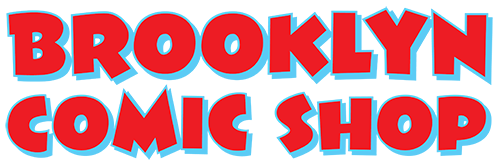
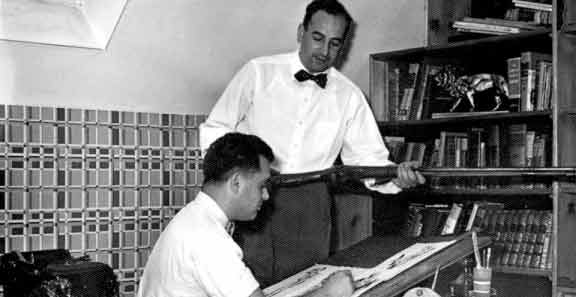
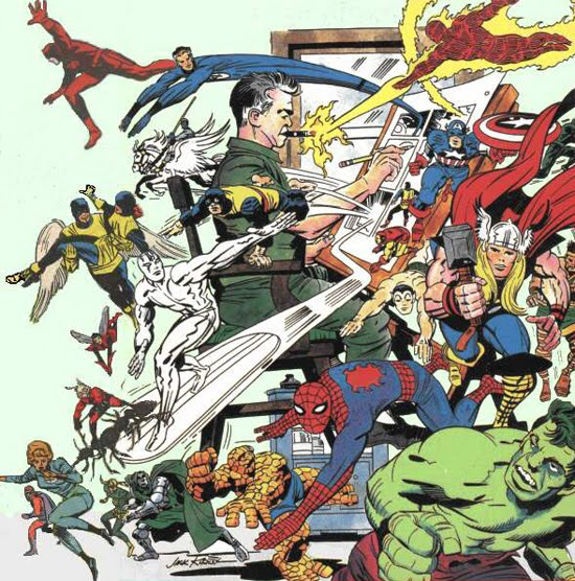
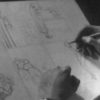
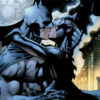






Leave a reply